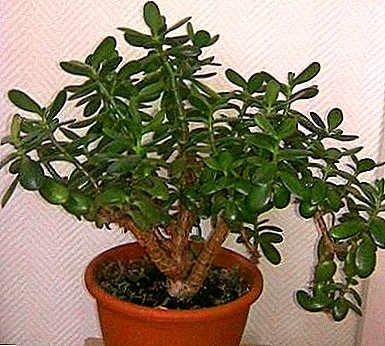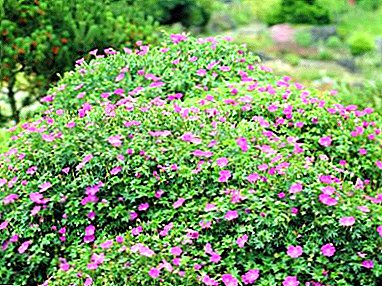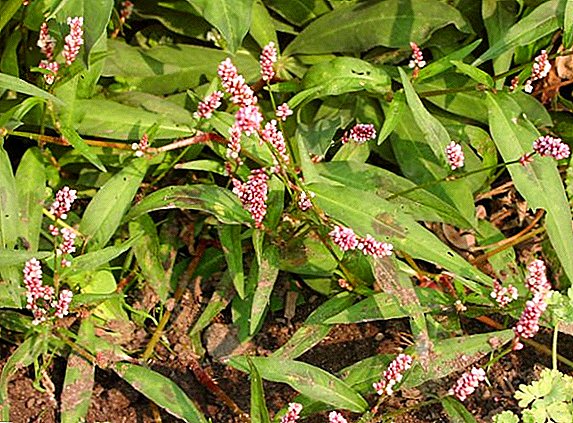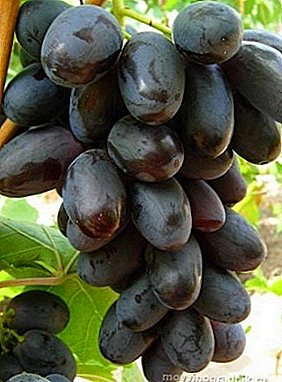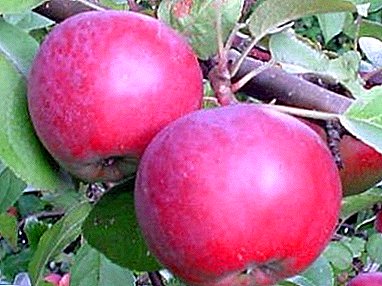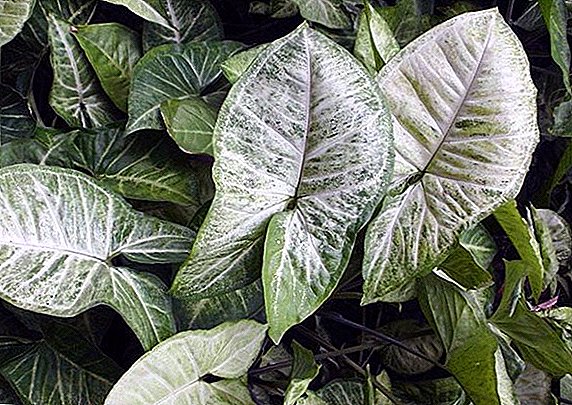 The syngonium is a fast-growing liana, which has won the attention of many gardeners all over the world with its unpretentiousness, beauty and a huge choice of various species. Find out more what kind of flower.
The syngonium is a fast-growing liana, which has won the attention of many gardeners all over the world with its unpretentiousness, beauty and a huge choice of various species. Find out more what kind of flower.
Description
From Greek, singonium is translated as "seed." This is a perennial liana growing in the tropical forests of America, belongs to the family of Aroids. More than 30 species grow in the wild, and less than half are cultivated.
Other decorative lianas also attract with their appearance: scandus, ivy, monstera, ipomoea, tradescantia, passionflower, philodendron, tunbergia, stephanotis.

Did you know? Only in the wild can you see the flowering of syngonium. At the end of spring white flowers appear on the vine, then fragrant berries are formed, which are very much loved by monkeys.
As an indoor ornamental plant, syngonium is very popular due to the variety of color and shape of leaves. This flower has the following characteristics:
- A flexible thin trunk with a large number of airy roots helps it cling to the supports.
- The leaves have different forms: in the form of a heart, spear-shaped, consisting of three parts. With age, their shape may change.
- The color of the foliage varies from light green (almost white) to dark green, with splashes of yellow.
- In floriculture the plant is used as a vine or as an ampelous plant.

Basic landing rules
Deciding to plant a singonium flower at home, you need to know that the plant does not cause much trouble, but you need to provide certain conditions for its decoration.
Choice of location and lighting
Syngonium loves scattered sunlight or partial shade. From direct sunlight, some varieties lose their brightness, and at the same time its lack leads to shredding of the foliage. The ideal option for placing pots for growing will be windows from the east and west sides.

Temperature and humidity
The temperature of the syngonium is tolerant. Indoors, it should not be above +25 ° C in summer and +17 ° C in winter.
Since the plant comes from the tropics, the air humidity plays an important role. To maintain it at the right level, you can use a special device. If you can not buy it, then spend daily foliar spraying and place the container with the plant in a pan with expanded clay, always keeping it moist. For spraying water must be taken at room temperature.
Plants such as aloe, geranium, kalanchoe, rosemary, hunk, golden mustache, agave, lemon, hibiscus are grown not only as ornamental plants, but also as medicinal.
Growing soil
The soil for planting is taken neutral or slightly acidic, light and consisting of leafy ground, peat, sand and humus in a ratio of 1: 1: 1: 0.5.

The addition of charcoal or bone meal to the earth will add nutrients to it. At the bottom of the pot it is necessary to fill the expanded clay (1/3 capacity to collect excess moisture), which will protect the roots from rotting.
Did you know? Syngonium can be grown without using the soil, in hydrogels of various colors or other nutrients. This method is called hydroponics and the plant is planted in this way, it looks very impressive in a transparent flowerpot.
Care instructions
As with the cultivation of other plants at home, you will have to take care of the syngonium in a certain way to get a healthy and beautiful-looking flower. Mandatory procedures include: watering, fertilizing, crown formation and transplanting.
Watering
The plant is moisture-loving and he needs regular watering. It is carried out as the earth dries out, that is, if the soil has dried up to 3 centimeters, it should be moistened. To do this, use filtered or settled for several days at room temperature water.

Once every 10 days you need to bathe the syngonium under the shower, carefully moistening the earthy ball in the pot. Moreover, the key to the decorative and health of the flower is its regular spraying, especially during the heating season, when there is dry air in the room due to central heating.
Fertilizers and fertilizers
Caring for the syngonium, in order to obtain a healthy plant at home, implies compulsory feeding with special compounds. They should be carried out, starting from spring and up to the autumn, with a frequency of twice a month. Perform this procedure using complex fertilizer for leafy plants. In winter, when the flower is at rest, the procedure is not carried out.
Crown formation
The beautiful ornamental plant is not only watering and top dressing, but also correctly formed krone.
Important! Trimming and pinching the branches should be carried out with gloves, as the sap of the plant causes skin irritation.

There are several ways for this procedure:
- Spring pruning of shoots to a length of 20 centimeters allows you to rejuvenate the plant. During the year, the branches of the syngonium grow up to 30 centimeters (approximately 6 sheets).
- Pinching shoots at a distance of 6 centimeters from the leaf allows for branching of existing shoots and growth of new ones. This technique allows you to create a bushy lush crown.
- A tube wrapped in moss is inserted into the center of the pot, which will support the syngonium. This is done when transplanting plants to another pot, so as not to damage the roots of the flower. Moss on the tube moisturize during watering. The plant with its aerial roots is well attached to it and twists on a support.
Transfer
The process of transplanting is a mandatory procedure that is necessary not only for the syngonium, but also for all indoor plants. In this case, several problems are solved:
- Complete replacement of depleted soil.
- Replacing the pot with a larger container for comfortable placement of an overgrown root system.

The procedure of transplantation is carried out according to the following scheme:
- A drainage layer of expanded clay (1/3 of the pot volume) is poured at the bottom of the tank.
- The plant is lowered into the prepared container, the roots gently straighten and covered with soil.
- The soil is slightly compacted and well filled with settled water to remove the remaining air. If after watering the soil subsided, it is necessary to fill it.
Reproduction of syngonium
The reproduction procedure at home is not laborious and is carried out in several ways: by dividing the shoots and grafting the upper part of the shoot of the syngonium.
The division of shoots
Step-by-step instruction:
- The branch of a liana is cut off and parts, about 14 centimeters long (with two buds) are cut with a sharp knife.
- Then they are put in plain water to branch roots. To stimulate the formation of roots, you can add "root" or activated charcoal. If rooting is carried out in wet peat or earth - shoots are placed horizontally.
- The container is covered with glass or film to create a microclimate with constant humidity and temperature of about +25 ° C.
- After the roots have gone to growth, the shelter is removed, and as soon as they reach a length of about 3 centimeters, the parts obtained are seated in prepared pots.

Apical cuttings
Sequence of operations:
- A sharp knife cuts off the upper part of the stem with a length of 15 centimeters with two leaves and one growth point.
- The lowermost leaf is removed, and the cutting is lowered for a couple of hours in a solution with a growth stimulator.
- In the prepared mixture of peat and sand (in equal parts) we bury the cutting to the remaining leaf.
- Well watered and covered with a jar to create a microclimate. The temperature inside the mini-greenhouse should not be below +23 ° C.
- It is necessary to constantly keep the ground moist.
- After three weeks, we remove the shelter, and when the roots are strengthened and reach a length of a couple of centimeters, plant the cuttings in prepared pots.
Important! Banks once a day should be removed for 5 minutes for airing, so that a large amount of moisture does not form a mold on the soil surface, which will lead to rotting of the cutting and then to its death.

Diseases and pests
The main pests of syngonium manifest themselves in different ways:
- The leaves began to curl, then the flower is struck by aphids. The favorite place of the pest is the lower part of the leaf plate. In this case, the syngonium stops growing, the leaves begin to lose color, turn yellow and fall off, leaving bare shoots. For the destruction of pests using insecticides, for example: "Decis", "Fitoverm" and others.
- The shield is infecting the leaves on both sides, so they dry out and die. Organophosphate insecticides such as Actellic (20 drops per liter of water) can be used for control.
- If brown spots appeared on the lower part of the foliage, it means it is thrips. They appear on the syngonium when the plant is kept in a hot room with dried air. To destroy the colonies of this pest can be the same drugs that are successfully used by aphids and shchitovki.
Flower Diseases:
- The stems rotting occurs at low air temperature and excessive watering.
- Those who are interested in what to do if the leaves of the syngonium start to turn yellow, it is worth knowing that the plant does not have enough mineral fertilizers and needs to be fed.
- Foliage is reduced in size - the flower lacks lighting. Move the pot closer to the window or place an additional light source nearby.
- The tips of the leaves dry up, turn brown, and over time they quickly fall off - the air in the room is too dry. It is necessary to put a humidifier or increase the number of sprays.

Signs and superstitions
There are many will accept and all sorts of superstitions that are associated with syngonium. It is rumored that:
- The plant can save the homeowner from disease.
- The flower, located near the bed, eliminates bad dreams and makes the night rest more complete.
- Helps owners to get rid of bad habits, to adapt well to the new environment and improves mental abilities.
- One of the main superstitions is the man-hater flower singonium. It is believed that where he grows men do not stay long. By the way, this applies to all climbers planted at home.
Did you know? From a biological point of view, the flower cleans and fills the house with positive energy. Since the plant's homeland is tropical forests, where it can grow up to 5 meters, and the height of the apartments does not allow it to reach such a length, the liana throws out the excess energy into the surrounding space.
Types of syngonium
The most popular varieties of syngonium grown in indoor floriculture:
- Knifelee. The leaves of a young plant are like spears, and with age, their shape changes and becomes like a foot.
- Ushkovaty. The leaves are very dense with a glossy finish, in adult specimens in the shape of ears. In the interstices of the stems grow aerial roots.
- Pink. The name speaks for itself - the foliage is painted in pale pink color.
- Brokant Foliage chocolate with red streaks that stand out.
- Wendland. On velvety, saturated-green leaves, there passes the central vein of silvery color.
- Pixie The leaves are clearly distinguished streaks of white color.
- Butterfly. Foliage color varies from white to pink.

 id: 48129 [/ img]
id: 48129 [/ img]







